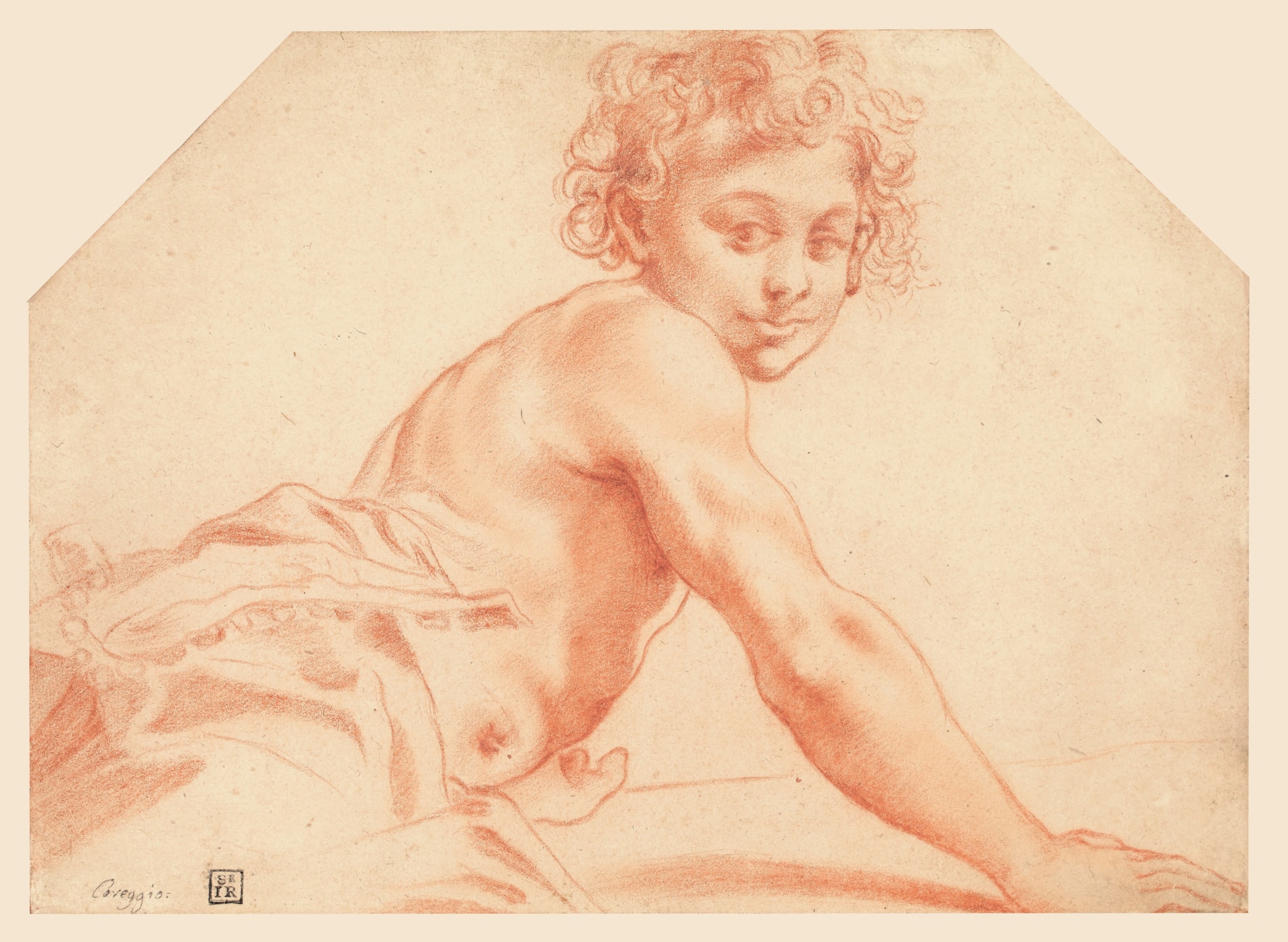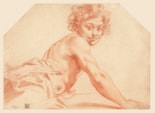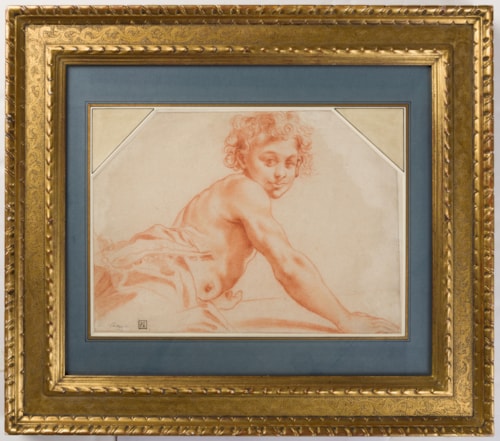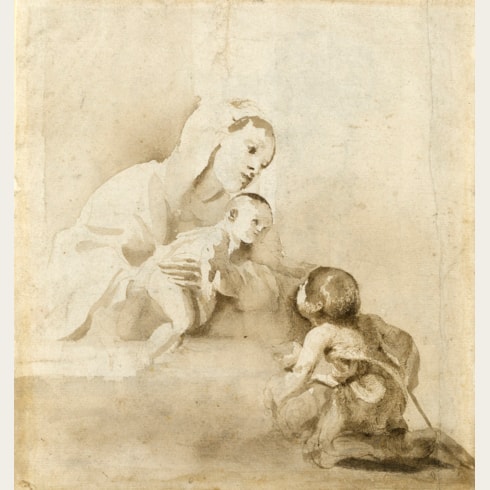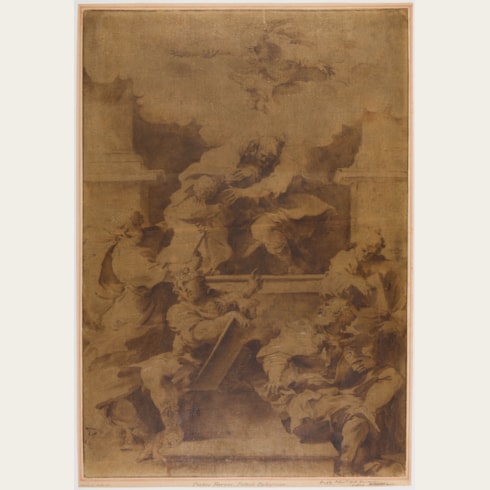Pietro FACCINI
(Bologna 1562 - Bologna 1602)
Study of a Seated Youth, Leaning to the Right
Red chalk, with stumping. The upper corners cropped.
Inscribed Coreggio at the lower left.
237 x 330 mm. (9 3/8 x 13 in.) at greatest dimensions.
Inscribed Coreggio at the lower left.
237 x 330 mm. (9 3/8 x 13 in.) at greatest dimensions.
The attribution of this beautiful drawing to Pietro Faccini was first proposed by Babette Bohn in 1991, and was subsequently confirmed by the late Mario di Giampaolo. The drawing shows the influence of Annibale Carracci in the use of soft, stumped red chalk, and probably dates to the period of Faccini’s study with Annibale in the late 1580s, when both artists were inspired by the drawings of Correggio. The Correggesque quality of this drawing is further evidence of its early date; indeed, it was long attributed to Correggio himself, as evidenced by the inscription at the lower left. The present sheet is, in fact, inspired by the figure of an ephebus in Correggio’s fresco of The Assumption of the Virgin on the cupola of the Duomo in Parma, painted in the second half of the 1520s. Faccini has omitted the foreshortened, dangling legs of Correggio’s figure and given the youth a more lively expression.
The soft, sensuous application of stumped red chalk to depict the play of light and shade on the nude form - note, for example, the way in which the artist has depicted the shadow of the youth’s arm as it falls across the side of his chest - is a characteristic feature of Pietro Faccini’s draughtsmanship of the 1580s. A stylistically comparable early drawing by Faccini of a Reclining Male Nude is in the Ashmolean Museum in Oxford, while in handling and effect a sheet of studies of Saint Francis in the Louvre provides a further point of comparison with this drawing.
It has recently been suggested that a red chalk study of a youth in the collection of the British Museum, where it is attributed to Annibale Carracci, may depict the same model. An interesting comparison may also be made with a drawing of a male nude by Annibale in the Louvre, which appears to be a similarly free interpretation of the type of youthful figure frescoed by Correggio on the cupola of the cathedral in Parma.
The soft, sensuous application of stumped red chalk to depict the play of light and shade on the nude form - note, for example, the way in which the artist has depicted the shadow of the youth’s arm as it falls across the side of his chest - is a characteristic feature of Pietro Faccini’s draughtsmanship of the 1580s. A stylistically comparable early drawing by Faccini of a Reclining Male Nude is in the Ashmolean Museum in Oxford, while in handling and effect a sheet of studies of Saint Francis in the Louvre provides a further point of comparison with this drawing.
It has recently been suggested that a red chalk study of a youth in the collection of the British Museum, where it is attributed to Annibale Carracci, may depict the same model. An interesting comparison may also be made with a drawing of a male nude by Annibale in the Louvre, which appears to be a similarly free interpretation of the type of youthful figure frescoed by Correggio on the cupola of the cathedral in Parma.
Pietro Faccini’s brief career seems to have begun at a relatively late age, when around 1583 he entered the Carracci academy in Bologna. His precocious talent is said to have aroused the jealousy of Annibale Carracci, however, and in the 1590’s Faccini left the Carracci academy, later setting up his own school. By this time he was already receiving independent commissions for altarpieces, and indeed the one known dated work by him, an early Martyrdom of Saint Lawrence painted for the Bolognese church of San Giovanni in Monte, was painted in 1590. He may have traveled to Venice, and the influence of Tintoretto noted by his biographer Cesare Malvasia is evident in some of his later works. According to Malvasia, Faccini was a productive painter known for his small-scale decorative pictures, although only a handful of paintings by him survive today. Held in high regard by his contemporaries, he was elected alongside Guido Reni and Francesco Albani as one of the fifteen consiglieri of the Compagnia dei Pittori in Bologna in 1599. One of his last major works was an altarpiece of The Assumption of the Virgin, painted for the church of Santa Maria dei Servi in Bologna. Although strongly influenced by both Annibale and Ludovico Carracci, Faccini developed a fairly idiosyncratic style, and unlike them had few obvious followers.
Aptly described by one scholar as ‘one of the most creative and original draughtsmen of the Emilian school’, Faccini worked in a variety of techniques, using pen and ink wash, red and black chalk, watercolour and oiled charcoal. He was an accomplished and versatile draughtsman, and his drawings were greatly admired for what Malvasia calls their ‘gran spirito’. They were especially popular with collectors, and Cardinal Leopoldo de’ Medici is said to have owned over a hundred drawings by the artist. Guercino also admired Faccini's drawings, which were a strong influence on his early chalk style, and is known to have possessed a number of ‘nudi d’accademia’ by the artist. In fact, Malvasia reserves special praise for Faccini’s drawings of the male nude, which he notes were often confused with those of Annibale Carracci: ‘so many drawings from the nude, that one sees an infinity of his models in all the most famous collections...so sensational, so darting, fluttering, and what is more, so easy and frank, that look as if they were by his master [ie. Annibale Carracci], many are sold every day as if the work of his hand.’ Important groups of drawings by Pietro Faccini, for the most part unpublished, are in the Uffizi, the Louvre, the Kupferstichkabinett in Berlin and the Galleria Estense in Modena.
Provenance
Sir Joshua Reynolds, London (Lugt 2364)
By descent to his niece, Mary Palmer, later Marchioness of Thomond
The posthumous Reynolds sales, London, A. C. de Poggi, 26 May 1794 onwards or London, H. Philips, 5-26 March 1798
John Bacon Sawrey Morritt, Rokeby Park, nr. Barnard Castle, County Durham
By descent to Major Henry Edward Morritt, Rokeby Park
Presumably Robin Morritt
Ian Woodner, New York
His posthumous sale, London, Christie’s, 6 July 1991, lot 105
P. & D. Colnaghi, London, in 1992
Acquired in 1992 by James Fairfax, Bowral, N.S.W., until 2010.
Literature
Catherine Legrand, Le dessin à Bologne 1580-1620: La réforme des trois Carracci, exhibition catalogue, Paris, 1994, p.101, under no.66; Jean Goldman, ‘A New Attribution to Pietro Faccini’, Antichità viva, 1996, Nos.2-3, pp.28-29, fig.3; Richard Beresford and Peter Raissis, The James Fairfax Collection of Old Master Paintings, Drawings and Prints, exhibition catalogue, Sydney, 2003, pp.82-83, no.21; Plymouth, Plymouth City Museum and Art Gallery, Sir Joshua Reynolds: The Acquisition of Genius, exhibition catalogue, 2009-2010, p.129, under no.55.
Exhibition
New York and London, Colnaghi, Master Drawings, 1992, no.18; Sydney, Art Gallery of New South Wales, The James Fairfax Collection of Old Master Paintings, Drawings and Prints, 2003, no.21.

